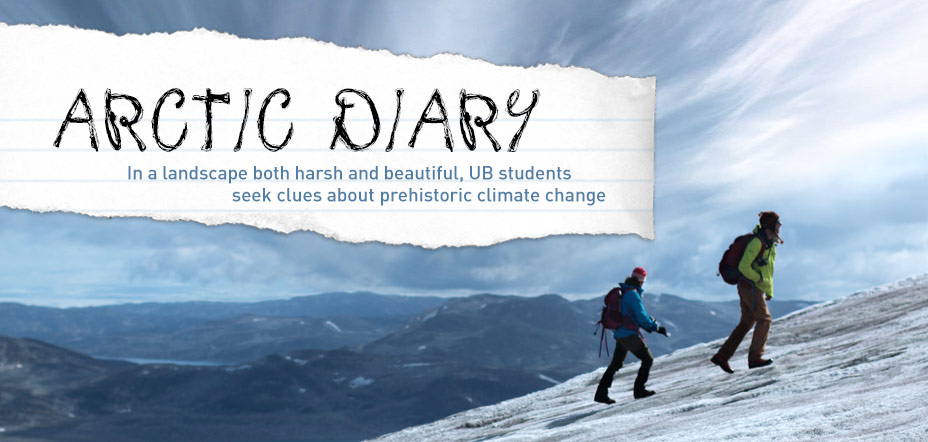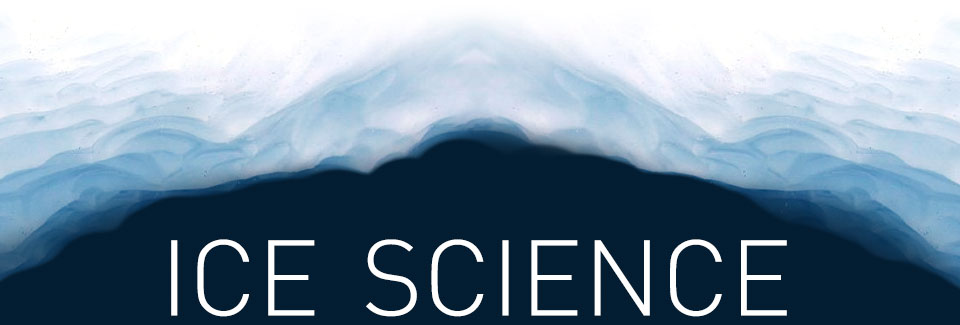
UB RENEW INSTITUTE
Studying Arctic glaciers is just one way that scientists in UB’s RENEW Institute are tackling today’s most pressing environmental concerns.
Here is what you bring with you on a three-week research expedition to Greenland, a place where summer temperatures often dip below freezing and the nearest towns are hundreds of miles away:
Maps. GPS devices. An inflatable raft. A generator and jerry cans of gasoline. To cook, you bring a kitchen tent, lighters and a kerosene stove. You pack pots, pans, pasta, hot sauce, rice, dehydrated beans, cheese, oatmeal, nuts, onions and, most crucially, coffee.
You bring a laptop and satellite phones. You carry bug spray. You wear a fleece jacket, rubber boots and long underwear beneath waterproof nylon pants. You bring hammers, tool boxes filled with chisels and various types of tubing. You pack a sledgehammer for breaking ice and a shovel for bathroom trips.
You lug all of this equipment with you onto a helicopter. The ride is intense, with several people crammed into a tiny space. The propellers thrum noisily.
Then, the copter lands and you step out into a world so stark and beautiful it’s hard to believe it’s real.
“Suddenly, your life becomes much simpler,” says UB Associate Professor of Geology Jason Briner, a veteran of these northern research trips. “That’s one of the things that’s so inviting about the Arctic. The science we do is cool, of course, but part of it is just about being in an expansive landscape where people don’t travel all the time.”
Briner brings students to Greenland, Alaska or Baffin Island about twice a year to ply the land for clues about the history of climate change. The work addresses one of the field’s enduring mysteries: how quickly glaciers can grow and melt [see “Ice Science,” below].
Life in the field is full of the unexpected, the unforeseen. Briner once emerged from the kitchen tent to find a polar bear some 100 yards away; the team warded the animal off with flares. Other days, white-outs swallow the camp, or mosquitoes and flies go on the attack.
Then there are moments of absolute wonder: long hikes that open onto views of blue glaciers; a sky clear as glass; an eagle wheeling around your boat. Briner recounts the distant boom of ice cracking and falling into fjords. In the darkness of night, he says, it sounds like thunder.
A typical morning in the Arctic starts with coffee and breakfast at 7 a.m., followed by a satellite phone call to the National Science Foundation logistics office to tell them you’re still alive. Then, the research begins. Entries from the diary of UB PhD student Avriel Schweinsberg provide a window into what everyday life is like. The excerpts are pieced together from various days she spent in the field in 2013.
THE DAY BEGINS
Woke up to the sound of local birds on top of my tent—it was great to hear them in the morning! Everyone gathered in the kitchen tent at 7 a.m. for breakfast, which was served quickly—I’m sure in anticipation of a long day up on the nearby local ice cap. Our plan for the day was to hike down to Pauiaivik Lake, use the boat to shuttle people across, hike up to the ice cap, and walk along the southern margin in search of vegetation and in-situ [Carbon-14] samples.
BREAKFAST
The morning was incredibly calm; the shallow lake immediately next to camp had reflections of nearby ice caps and crystalline peaks. Breakfast included coffee and oatmeal with dried blueberries, brown sugar and blueberry flavored craisins.
SETTING OUT
The morning hike was quite enjoyable; everyone was upbeat and excited to get to our destination. ... We reached the end of the rolling bedrock terrain at ~9:35 a.m. (an hour from camp), and then proceeded to attempt to contour around a massif to reach the appropriate valley. This next section took us about an hour to complete, and wasn’t too bad. We saw new wildlife—an Arctic hare.
A DIFFICULT TREK… AND A PAYOFF
It was clear that our trek down and up would not be easy. Nearly a straight drop, we climbed down tundra, talus and bedrock. … The view of the glacier was stunning—beautiful blue and white ice carving out bedrock with ice-contact drift and ground moraines beyond the snout. The glacier had meltwater streams that fed brightly colored blue and teal water into the fjord that was littered with ice bergs and sediment blooms.
MIDDAY BREAK
Lunch was on a small bedrock donut near the ice cap margin; standard food items: hard salami, Swiss and gouda cheese, Cajun trail mix, dried apricots, nasty Tomato and Basil Triscuits, 1.5-week-old sunflower bread and dried mango slices.
TAKING SAMPLES
This was the first day where Jason let me control the coring system—it was great fun! Coring is extremely cold on the hands, but other than that it’s not too bad. We collected 3 cores from the basin in the forefront of the LIA moraines, all of which include the sediment sequence from deglacial to present. I didn’t have too much trouble getting the hang of things, and Jason said I did great! Hopefully these cores turn out well since they will be part of my PhD work. Editor's note: Sediment coring is the process of collecting cylinder-shaped samples from areas of interest, such as the bottoms of prehistoric lakes.
FIGHTING THE ELEMENTS
The ice cap crossing took ~55 minutes and every step sunk your boots into ice cold slush—with the wind blasting all of us in the face, it wasn’t the most pleasant walk.
WINDING DOWN
Dinner was burritos as asked for by the tired hikers: flour tortillas, refried beans, taco meat, cheddar cheese and optional hot sauce. Sandra made a special dessert which was delicious—melted milk chocolate with almonds and crunchy peanut butter wrapped in a buttered and sautéed tortilla. Big meal before a big hike tomorrow!




